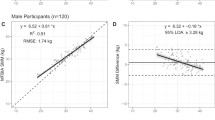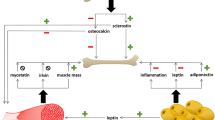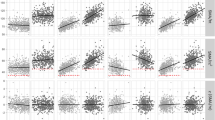Abstract
Objective:
To investigate the relationships between regional skeletal muscle mass (SM mass) and bone mineral indices and to examine whether bone mineral content (BMC) normalized to SM mass shows a similar decrease with age in young through old age.
Subjects/Methods:
One hundred and thirty-eight young and postmenopausal women aged 20–76 years participated in this study and were divided into three groups: 61 young women, 49 middle-aged postmenopausal women and 28 older postmenopausal women. Muscle thickness (MTH) was determined by ultrasound, and regional SM mass (arm, trunk and leg) was estimated based on nine sites of MTH. Whole-body and regional lean soft tissue mass (LSTM), bone mineral density (BMD) and BMC (whole body, arms, legs and lumbar spine) were measured using dual-energy X-ray absorptiometry.
Results:
Ultrasound spectroscopy indicated that SM mass is significantly correlated with site-matched regional bone mineral indices and these relationships correspond to LSTM. The BMC and BMD in older women were significantly lower than those in middle-aged women. When BMC was normalized to site-matched regional SM mass, BMC normalized to SM mass in arm and trunk region were significantly different with age; however, whole-body and leg BMC normalized to SM mass showed no significant difference between middle-aged and older postmenopausal women.
Conclusions:
The age-related differences in BMC were found to be independent of the ageing of SM mass in the arm and trunk region. However, differences in BMC measures of the leg and whole body were found to correspond to age-related decline of SM mass in postmenopausal women.
This is a preview of subscription content, access via your institution
Access options
Subscribe to this journal
Receive 12 print issues and online access
$259.00 per year
only $21.58 per issue
Buy this article
- Purchase on Springer Link
- Instant access to full article PDF
Prices may be subject to local taxes which are calculated during checkout


Similar content being viewed by others
References
Abe T, Kawakami Y, Suzuki Y, Gunji A, Fukunaga T (1997). Effects of 20 days bed rest on muscle morphology. J Gravit Physiol 4, S10–S14.
Abe T, Kondo M, Kawakami Y, Fukunaga T (1994). Prediction equations for body composition of Japanese adults by B-mode ultrasound. Am J Hum Biol 6, 161–170.
Bevier WC, Wiswell RA, Pyka G, Kozak KC, Newhall KM, Marcus R (1989). Relationship of body composition, muscle strength, and aerobic capacity to bone mineral density in older men and women. J Bone Miner Res 4, 421–432.
Blain H, Vuillemin A, Teissier A, Hanesse B, Guillemin F, Jeandel C (2001). Influence of muscle strength and body weight and composition on regional bone mineral density in healthy women aged 60 years and over. Gerontology 47, 207–212.
Di Monaco M, Di Monaco R, Manca M, Cavanna A (2000). Handgrip strength is an independent predictor of distal radius bone mineral density in postmenopausal women. Clin Rheumatol 19, 473–476.
Dixon WG, Lunt M, Pye SR, Reeve J, Felsenberg D, Silman AJ et al. (2005). Low grip strength is associated with bone mineral density and vertebral fracture in women. Rheumatology (Oxford) 44, 642–646.
Ferretti JL, Capozza RF, Cointry GR, Capiglioni R, Roldan EJ, Zanchetta JR (2000). Densitometric and tomographic analyses of musculoskeletal interactions in humans. J Musculoskelet Neuronal Interact 1, 31–34.
Gleeson PB, Protas EJ, LeBlanc AD, Schneider VS, Evans HJ (1990). Effects of weight lifting on bone mineral density in premenopausal women. J Bone Miner Res 5, 153–158.
Hagberg JM, Zmuda JM, McCole SD, Rodgers KS, Ferrell RE, Wilund KR et al. (2001). Moderate physical activity is associated with higher bone mineral density in postmenopausal women. J Am Geriatr Soc 49, 1411–1417.
Henderson NK, Price RI, Cole JH, Gutteridge DH, Bhagat CI (1995). Bone density in young women is associated with body weight and muscle strength but not dietary intakes. J Bone Miner Res 10, 384–393.
Kanehisa H, Miyatani M, Azuma K, Kuno S, Fukunaga T (2004). Influences of age and sex on abdominal muscle and subcutaneous fat thickness. Eur J Appl Physiol 91, 534–537.
Kassem M, Melton L, Riggs B (1996). The Type 1/Type 2 Model for Involutional Osteoporosis. Academic Press: San Diego.
Kawakami Y, Abe T, Fukunaga T (1993). Muscle-fiber pennation angles are greater in hypertrophied than in normal muscles. J Appl Physiol 74, 2740–2744.
Lynch NA, Ryan AS, Berman DM, Sorkin JD, Nicklas BJ (2002). Comparison of VO2max and disease risk factors between perimenopausal and postmenopausal women. Menopause 9, 456–462.
Nguyen TV, Sambrook PN, Eisman JA (1998). Bone loss, physical activity, and weight change in elderly women: the Dubbo Osteoporosis Epidemiology Study. J Bone Miner Res 13, 1458–1467.
NIH Consensus Development Panel on Osteoporosis Prevention D, Therapy (2001). Osteoporosis prevention, diagnosis, and therapy. JAMA 285, 785–795.
Osei-Hyiaman D, Ueji M, Toyokawa S, Takahashi H, Kano K (1999). Influence of grip strength on metacarpal bone mineral density in postmenopausal Japanese women: a cross-sectional study. Calcif Tissue Int 64, 263–266.
Peterson SE, Peterson MD, Raymond G, Gilligan C, Checovich MM, Smith EL (1991). Muscular strength and bone density with weight training in middle-aged women. Med Sci Sports Exerc 23, 499–504.
Pfeifer M, Sinaki M, Geusens P, Boonen S, Preisinger E, Minne HW (2004). Musculoskeletal rehabilitation in osteoporosis: a review. J Bone Miner Res 19, 1208–1214.
Pluijm SM, Visser M, Smit JH, Popp-Snijders C, Roos JC, Lips P (2001). Determinants of bone mineral density in older men and women: body composition as mediator. J Bone Miner Res 16, 2142–2151.
Pongchaiyakul C, Nguyen TV, Kosulwat V, Rojroongwasinkul N, Charoenkiatkul S, Eisman JA et al. (2004). Effects of physical activity and dietary calcium intake on bone mineral density and osteoporosis risk in a rural Thai population. Osteoporos Int 15, 807–813.
Reimers CD, Harder T, Saxe H (1998). Age-related muscle atrophy does not affect all muscles and can partly be compensated by physical activity: an ultrasound study. J Neurol Sci 159, 60–66.
Rittweger J, Beller G, Ehrig J, Jung C, Koch U, Ramolla J et al. (2000). Bone-muscle strength indices for the human lower leg. Bone 27, 319–326.
Ross R, Jacson A (1990). Exercise, Concepts, Calculations, and Computer Applications. Benchmark Press: Carmel, IN.
Ryan AS, Elahi D (1998). Loss of bone mineral density in women athletes during aging. Calcif Tissue Int 63, 287–292.
Ryan AS, Nicklas BJ, Dennis KE (1998). Aerobic exercise maintains regional bone mineral density during weight loss in postmenopausal women. J Appl Physiol 84, 1305–1310.
Sanada K, Kearns CF, Midorikawa T, Abe T (2006). Prediction and validation of total and regional skeletal muscle mass by ultrasound in Japanese adults. Eur J Appl Physiol 96, 24–31.
Schiessl H, Frost HM, Jee WS (1998). Estrogen and bone-muscle strength and mass relationships. Bone 22, 1–6.
Schonau E (2004). The peak bone mass concept: is it still relevant? Pediatr Nephrol 19, 825–831.
Sinaki M, Itoi E, Wahner HW, Wollan P, Gelzcer R, Mullan BP et al. (2002). Stronger back muscles reduce the incidence of vertebral fractures: a prospective 10 year follow-up of postmenopausal women. Bone 30, 836–841.
Szulc P, Beck TJ, Marchand F, Delmas PD (2005). Low skeletal muscle mass is associated with poor structural parameters of bone and impaired balance in elderly men—the MINOS study. J Bone Miner Res 20, 721–729.
Walsh MC, Hunter GR, Livingstone MB (2006). Sarcopenia in premenopausal and postmenopausal women with osteopenia, osteoporosis and normal bone mineral density. Osteoporos Int 17, 61–67.
Acknowledgements
We gratefully acknowledge the dedicated women who participated in this project. We are also grateful for the technical support provided by Ms Naeko Kurose, and Ms Yumi Omori (National Institute of Health and Nutrition). This study was partly supported by ‘Establishment of Consolidated Research Institute for Advanced Science and Medical Care,’ Encouraging Development Strategic Research Centers Program, Special Coordination Funds for Promoting Science and Technology, Ministry of Education, Culture, Sports, Science and Technology, Japan, a grant from the ministry of Health, Labor and Welfare of Japan.
Author information
Authors and Affiliations
Corresponding author
Rights and permissions
About this article
Cite this article
Sanada, K., Miyachi, M., Tabata, I. et al. Muscle mass and bone mineral indices: does the normalized bone mineral content differ with age?. Eur J Clin Nutr 63, 465–472 (2009). https://doi.org/10.1038/sj.ejcn.1602977
Received:
Revised:
Accepted:
Published:
Issue Date:
DOI: https://doi.org/10.1038/sj.ejcn.1602977
Keywords
This article is cited by
-
Exploring the Link between Serum Phosphate Levels and Low Muscle Strength, Dynapenia, and Sarcopenia
Scientific Reports (2018)
-
A cross-sectional study of sarcopenia in Japanese men and women: reference values and association with cardiovascular risk factors
European Journal of Applied Physiology (2010)



